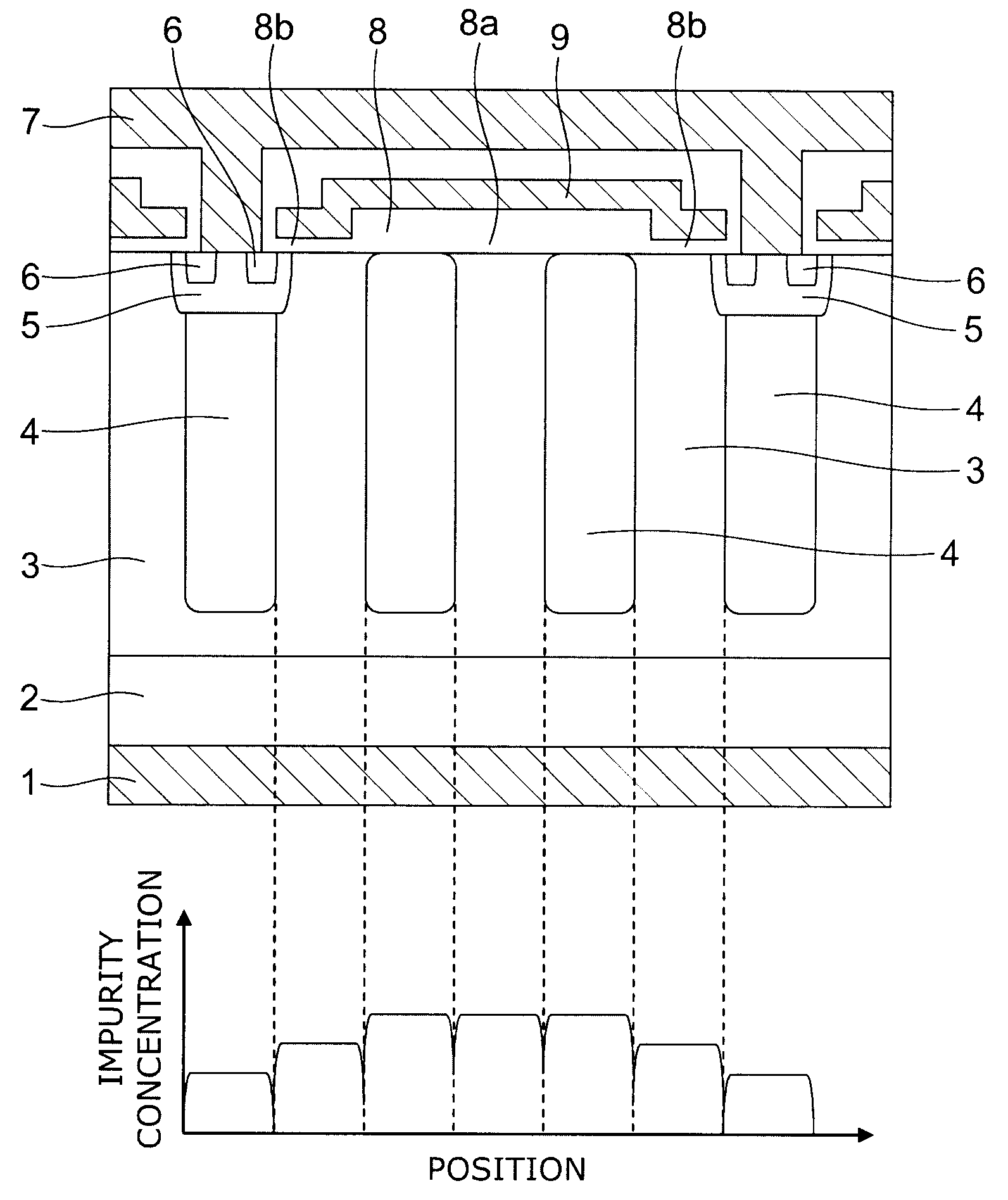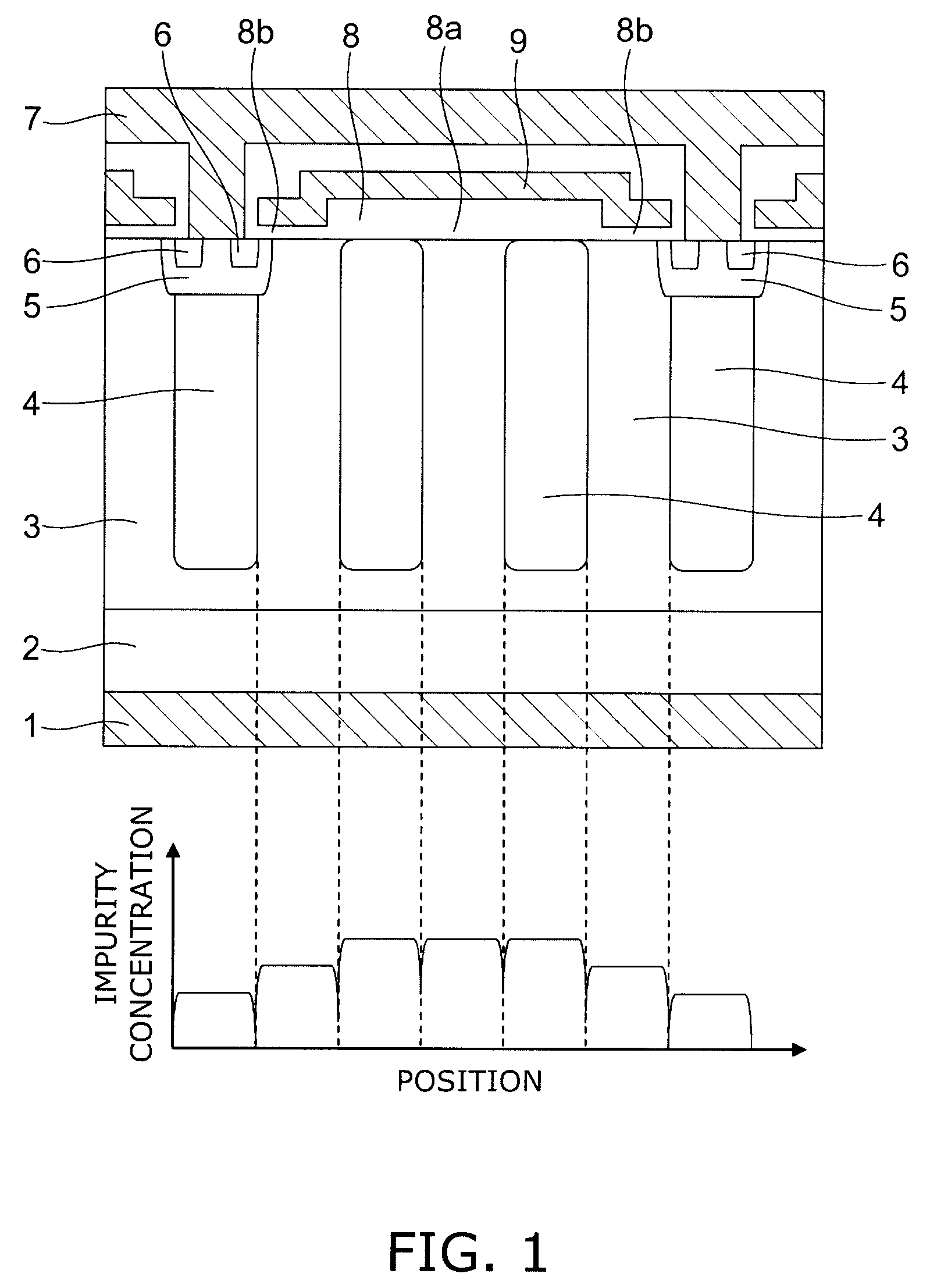Power semiconductor device
a technology of semiconductor devices and semiconductors, applied in the direction of semiconductor devices, basic electric elements, electrical equipment, etc., can solve the problems of low breakdown voltage, complex process steps, and trade-off between device breakdown voltage and breakdown voltag
- Summary
- Abstract
- Description
- Claims
- Application Information
AI Technical Summary
Benefits of technology
Problems solved by technology
Method used
Image
Examples
first embodiment
Modified Example of First Embodiment
[0044]FIG. 3 is a cross-sectional view schematically illustrating a power MOSFET according to a modified example of the first embodiment and a graphic view illustrating a profile of an impurity concentration of a SJ structure, in which the horizontal axis is position of the lateral direction in the SJ structure and the vertical axis is pillar concentration.
[0045]As shown in FIG. 3, in the power MOSFET according to this modified example, an array period of the p-base layers 5 is large, compared to the power MOSFET according to the above-described first embodiment. Moreover, the peripheral portion of the gate electrode 9 is formed diagonally. More specifically, both end portions of the gate electrode 9 in a longitudinal direction extend in the direction inclining to the upper surface of the n+ drain layer 2. Furthermore, the impurity concentration of each of the pillar layers has an intermediate value of the impurity concentrations of the pillar lay...
second embodiment
[0047]FIG. 4 is a perspective cross-sectional view schematically illustrating a power MOSFET according to a second embodiment of this invention and a graphic view illustrating a profile of an impurity concentration of a SJ structure, in which the horizontal axis is position of the lateral direction in the SJ structure and the vertical axis is pillar concentration.
[0048]As shown in FIG. 4, in the power MOSFET according to this embodiment, the n-pillar layers 3 and the p-pillar layers 4 are formed in a stripe form. Also, the p-base layers 5 are formed in a stripe form and extend along the array direction (lateral direction) of the n-pillar layers 3 and the p-pillar layers 4. That is, the direction to which the p-base layers 5 extend is orthogonal to the direction to which the n-pillar layers 3 and the p-pillar layers 4 extend. Furthermore, the gate electrode 9 is also formed in a stripe form and extends in the direction orthogonal to the direction to which the p-base layers 5 extend, ...
third embodiment
Modified Example of Third Embodiment
[0056]FIG. 6 is a perspective cross-sectional view schematically illustrating a power MOSFET according to a modified example of the third embodiment and a graphic view illustrating a profile of an impurity concentration of a SJ structure, in which the vertical axis is position in the longitudinal direction in the SJ structure and the horizontal axis is pillar concentration.
[0057]As shown in FIG. 6, in the power MOSFET according to this embodiment, the impurity concentration profile of the n-pillar layer 3 and the impurity concentration profile of the p-pillar layer 4 have reverse gradients to each other. That is, along the direction from the source electrode 7 toward the drain electrode 1, the impurity concentration of the p-pillar layer 4 continuously decreases and the impurity concentration of the n-pillar layer 3 continuously increases. Thereby, in a part of the side of the source electrode 7 in the SJ structure, the impurity concentration in t...
PUM
 Login to View More
Login to View More Abstract
Description
Claims
Application Information
 Login to View More
Login to View More - R&D
- Intellectual Property
- Life Sciences
- Materials
- Tech Scout
- Unparalleled Data Quality
- Higher Quality Content
- 60% Fewer Hallucinations
Browse by: Latest US Patents, China's latest patents, Technical Efficacy Thesaurus, Application Domain, Technology Topic, Popular Technical Reports.
© 2025 PatSnap. All rights reserved.Legal|Privacy policy|Modern Slavery Act Transparency Statement|Sitemap|About US| Contact US: help@patsnap.com



